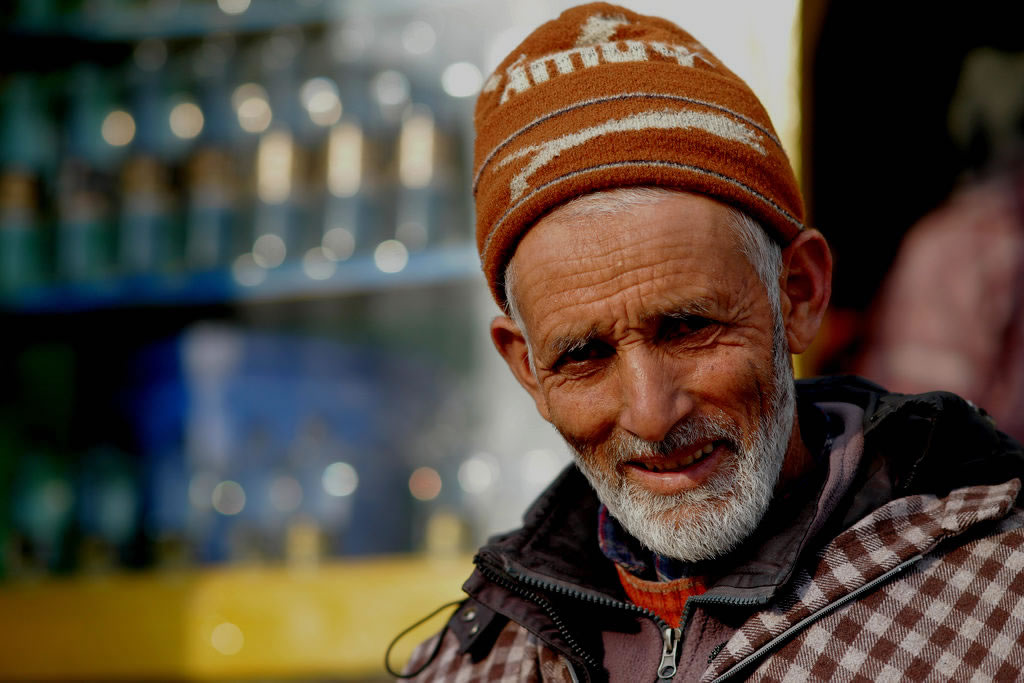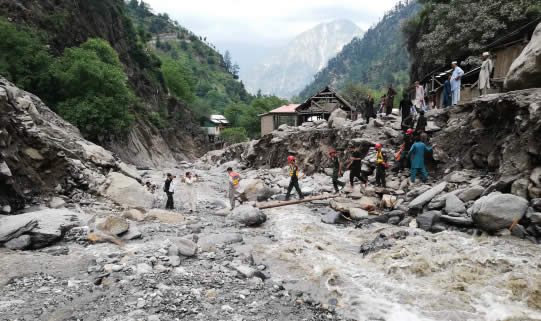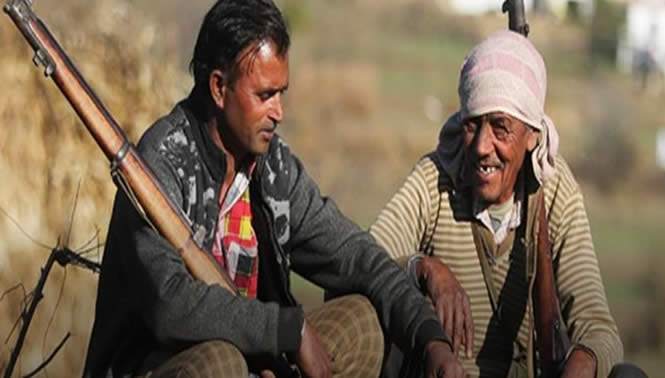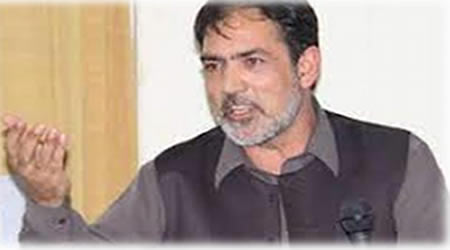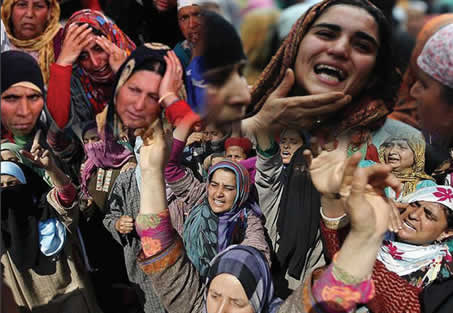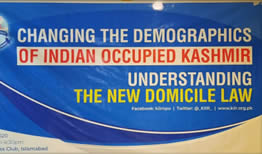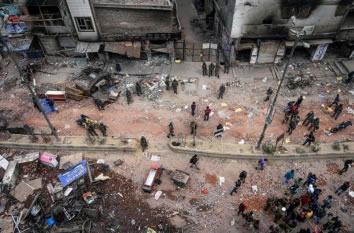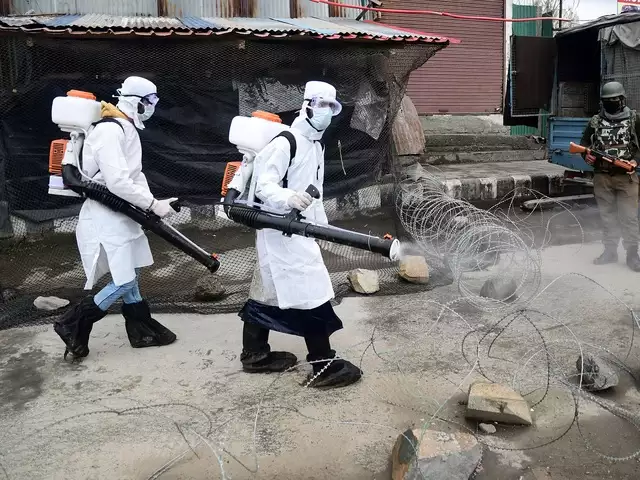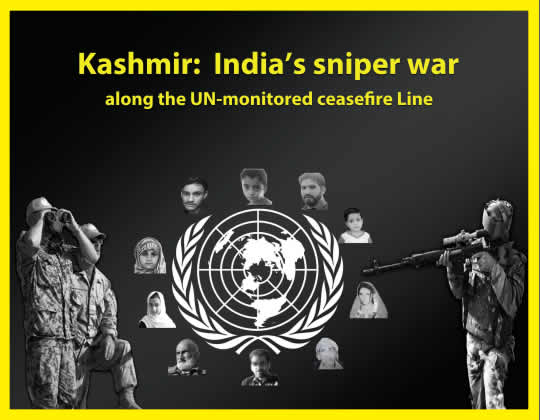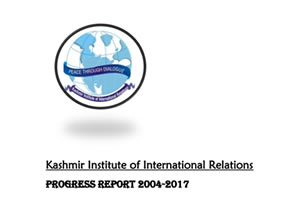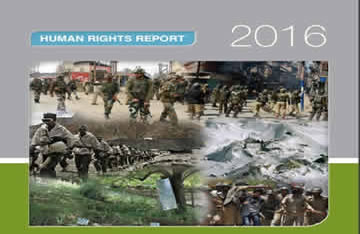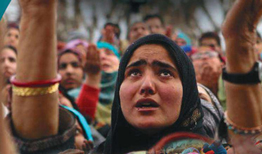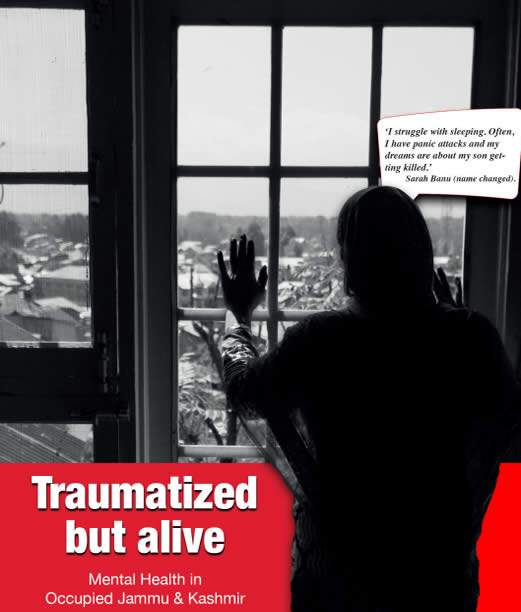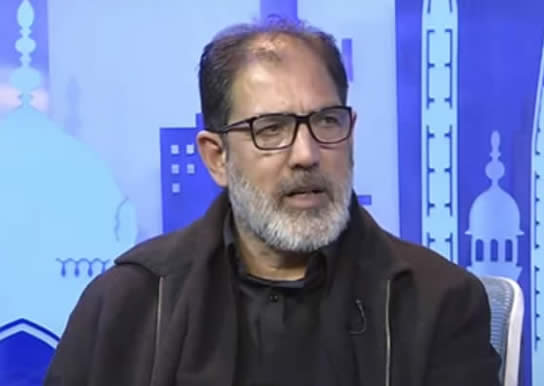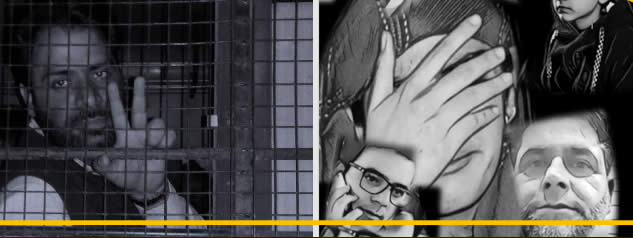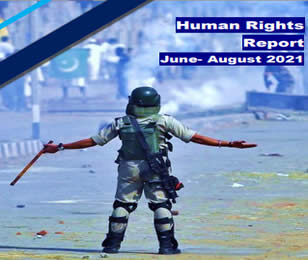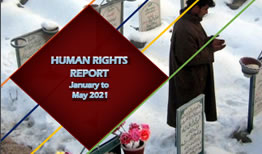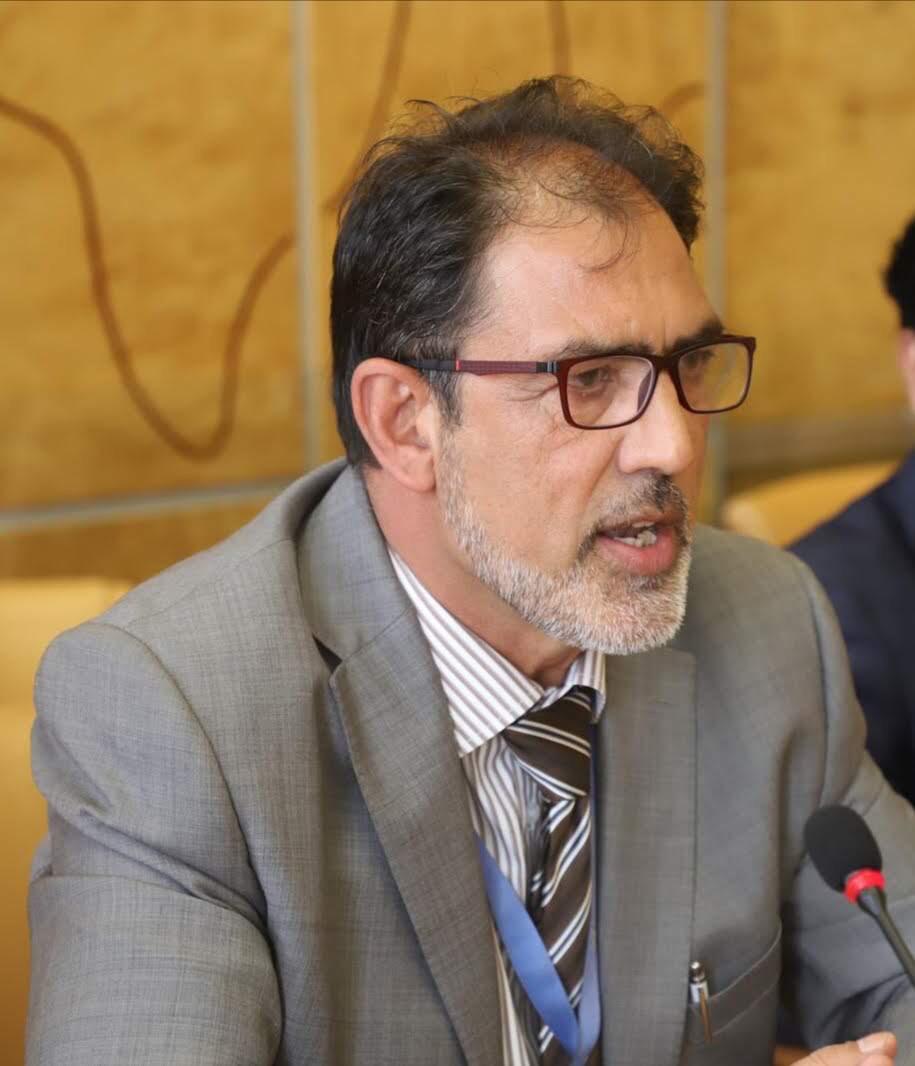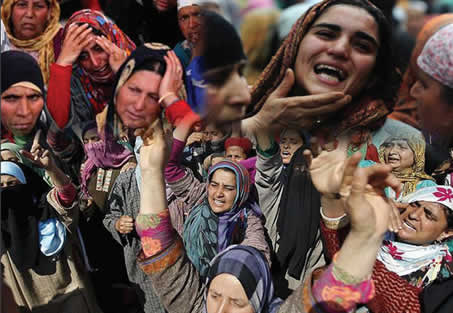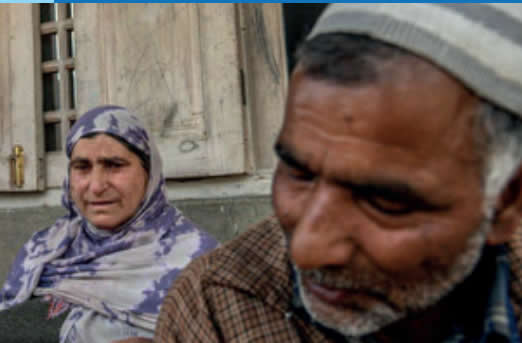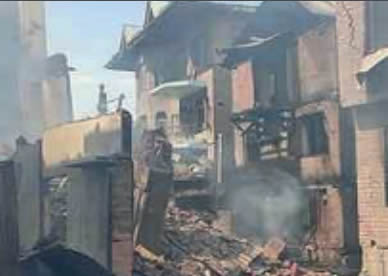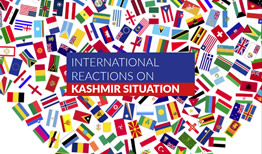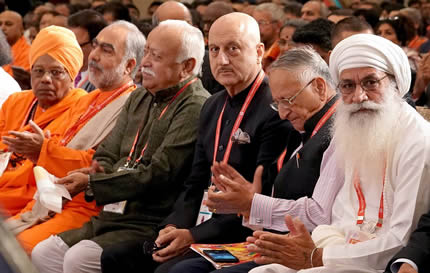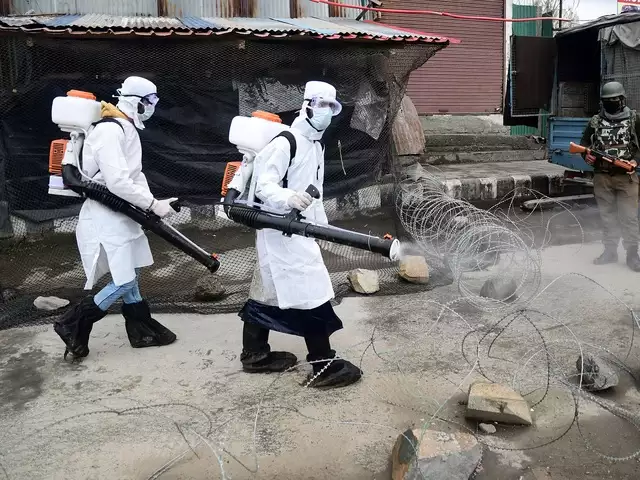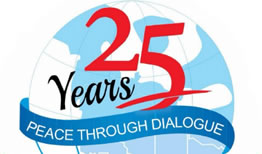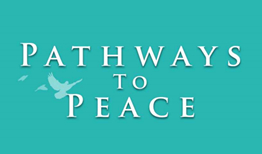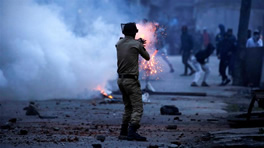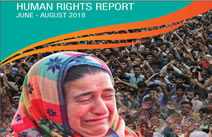India’s false flag operations in Indian occupied territory of Jammu and Kashmir
India’s false flag operations in Indian occupied territory of Jammu and Kashmir
Kidnapping of western tourists in 1995
In 1995, just six years after the onset of the ongoing freedom movement, Kashmir was shaken by the news of the kidnapping of six Western tourists while they were hiking in the scenic Pahalgam region. The incident sent shockwaves through diplomatic circles, as the abducted tourists were not ordinary citizens of developing countries, but nationals of influential world powers, including the United States, the United Kingdom, Germany, and Norway.
Al-Faran—a group unheard of before this incident—claimed responsibility for the abductions, demanding the release of jailed militants who had been arrested by Indian "security" forces during military operations in the region. However, the Indian authorities refused to meet any of the group's demands. Surprisingly, there were no direct negotiations between the Indian government and Al-Faran; instead, communication between the two sides was typically relayed through local intermediaries—such as villagers, journalists, or unofficial contacts—and indirect channels involving non-governmental figures.
The Indian government raised a hue and cry over the incident, blaming Kashmiri freedom fighters and Pakistan for the abduction of foreign tourists, it made no serious effort to track them down. New Delhi’s lackadaisical approach led to the execution of one hostage, while the remaining five—now presumed dead—were never found.
India’s bid to mold world opinion on Kashmir
The incident dealt a serious blow to the Kashmiri freedom movement, which was at its peak in the mid-1990s. During this period, the region—particularly the Kashmir Valley—witnessed massive crowds filling the streets across its length and breadth, demanding Azadi (freedom) and an end to India's illegal occupation of their homeland. The massive mass-mobilization of the Kashmiri people had shaken the very foundations of India. This was, in fact, one of the first times that India felt it was losing control over the Kashmir Valley.
The tourist kidnapping incident provided a much needed stick to India to beat both Pakistan and Kashmir and simultaneously mold world opinion in its favour. This is what Victoria Schofield in her analysis of the 1995mtourist kidnapping observed. Although her phrasing might differ slightly but Schofield argues that the kidnapping of the tourists served as a political tool for India, allowing India to shape world opinion by highlighting Pakistan's involvement in widespread uprising against India in Kashmir Immediate Fallout
Following the incident the U.S, U.K, Germany, and Norway were outraged at the handling of the situation. Western governments pressured India for answers, but were given only vague or misleading reports: emphasising on Pakistani-backed militants’ involvement in the incident. Using the incident as pretext, the Indian state has been, to a large extent, successful in pushing its narrative of Pakistan exporting “terror” into Kashmir. As a result global sympathy shifted toward India — and away from the real issue of Kashmir. And western media started to describe Kashmiris’ liberation struggle as "Islamic terrorism" rather than a nationalist movement. It was probably the first diplomatic success for India that the kidnapping of foreign tourists not only helped it to gain international support but also delegitimizing the Kashmiris´ indigenous struggle.
Secondly, the incident enabled the government of Indian to deflect world attention away from the killings of thousands of Kashmiris who were killed in Kashmir that year The Norwagian tourist Ostro’s mutilated body1, and the anxious, endless search for the other men, rapidly stanched a growing international acknowledgement that what Kashmir was witnessing was an uprising against India.
Truth revealed
After years of confusion surrounding the incident, the truth was revealed by acclaimed investigative journalists Adrian Levy and Cathy Scott-Clark in her book2—The Meadow: Kashmir 1995 – Where the Terror Began. Delving into the details of the mysterious kidnapping of the Western tourists in Kashmir, the acclaimed authors lifted the lid off the pot, showing how the incident was manipulated by India to give a communal colour to
Kashmiri resistance.
The book, based on years of field research, interviews and leaked documents, was later released in the United States under the title The Meadow: Terrorism, Kidnapping and Conspiracy in Paradise
What The Meadow claims
The book, presenting a detailed account of the incident, claims:
a) The Indian intelligence services (specifically the Research and Analysis Wing - RAW, and military intelligence) knew very early where the hostages were being kept.
b) Instead of rescuing them, Indian authorities chose to let the situation continue, hoping that the deaths of the hostages would discredit Pakistan internationally by linking the abductions to “Pakistani-backed militants”.
c) The Indian forces had infiltrators inside Al-Faran, and could have intervened.
d) Indian security forces deliberately obstructed negotiations. Offers from mediators to secure the hostages’ release (through prisoner swaps) were either rejected or slow-walked until it was too late.
Key highlights of the Book
I. A surrendered militant, “Azad Nabi”, was reportedly used by Indian forces to track the hostages — but his information was ignored.
II. There were repeated instances where Indian forces got close to the hideouts but retreated—at the eleventh hour—without engaging.
III. After the killings, a major cover-up operation ensued: several people who knew too much were reportedly silenced or disappeared.
IV. The Book suggests that Indian agencies knowingly sacrificed the lives of the hostages for strategic geopolitical gain, by manipulating a militant group they partly controlled or monitored. Why would Indian agencies allow this?
In 1995, India was under pressure from influential world governments to start negotiating with Kashmiri freedom fighters to resolve the longstanding dispute peacefully.
1 https://caravanmagazine.in/reviews-essays/dogs-war
2 https://www.thetimes.com/article/the-meadow-kashmir-1995-where-the-terror-began-by-adrian-levy-and- cathy-scott-clark-2f37qldm0mx
However, the Indian state, unwilling to compromise on Kashmir, was desperate to prove to the
world that Pakistan was actively “sponsoring terrorism in Kashmir”.
By framing the hostage crisis as a brutal example of "Islamic terrorism" backed by Pakistan, India hoped to win diplomatic support and shift global sympathy away from the Kashmir situation. Indian response to the Book
Though the Indian officials dismissed the book’s claims, but never provided detailed rebuttals.
Even some senior Indian and foreign diplomats have quietly admitted that the version presented by Levy and Scott-Clark is credible.
Some families of the abducted tourists later supported the findings of—The Meadow—and accused Indian authorities of "callous disregard for human life."
Pahalgam Tourist Attack
A mirror image of 1995 abduction of western tourists The recent assault on tourists by unidentified attackers in Pahalgam—a heavily guarded tourist destination in the Kashmir valley—presents shocking parallels with the 1995 abduction of Western tourists. These parallels primarily revolve around the scale of violence employed to attract global attention and the strategic manipulation of circumstances to further hidden goals or agendas. Striking similarities between the two incidents
Again a militant group (TRF) surfaced to claim the responsibility but later retracted, attributing the initial message to a cyberattack orchestrated by Indian intelligence. The attribution of the act to TRF was "false, hasty, and part of an orchestrated campaign to malign the Kashmiri resistance3.
FIR, filed 10 minutes after attack, suggests Indian narrative was pre-scripted
The FIR registered at 14:30 states that the assault occurred between 13:50 and 14:20pm local time.Sources argue that this timeline suggests foreknowledge of the incident.4
Indian authorities and media have portrayed the incident as a case of targeted killing, but the FIR describes it as indiscriminate firing — further deepening discrepancies. Primarily, the key parties—notably the Kashmiris and the Pakistan—blamed for orchestrating the attack, have unequivocally condemned the incident and demanded an international probe into the incident.
The government of Pakistan on its part has expressed its willingness to fully cooperate, calling for a neutral probe into Kashmir attack5. Following the Pahalgam incident, Indian authorities have exploited this human tragedy to escalate their campaign of repression in occupied Jammu and Kashmir. Rather than addressing the root causes of the unrest or conducting a transparent investigation, the state has intensified its policy of collective punishment.
Days after the attack, thousands of Kashmiris have been arbitrarily detained, often without due process. Among those targeted are not only suspected individuals, but also relatives of alleged “militants”, some of whom are already imprisoned. In a disturbing show of state power, their family homes have been demolished, signaling a growing trend of punitive demolitions that violate both domestic constitutional guarantees and international human rights norms.
Following the April 22, 2025, attack in Pahalgam, Indian authorities have detained over 1,500 individuals6 across Jammu and Kashmir. This extensive crackdown includes the demolition of homes belonging to alleged “militants or their relatives”.
In addition to these detentions, at least 24 people, including students, retired teachers, and a lawyer, have been arrested in the northeastern states7 of Assam, Meghalaya, and Tripura for remarks made on social media concerning the Pahalgam attack. These actions have raised concerns among human rights organizations and local leaders, who argue that such measures may constitute collective punishment and could further alienate the local population. Politicians in Kashmir have criticised the Indian authorities’ crackdown after the attack. Incumbent Chief Minister Omar Abdullah, former chief minister Mehbooba Mufti and others have voiced their serious concern over the fresh witch-hunting of Kashmiris and cautioned New Delhi against collective punishment of Kashmiris.
Without mincing words Member Parliament and National Conference leader Ruhullah Mehdi stated that Kashmir and Kashmiris are facing “collective punishment”. These statements vividly reflect the highly volatile situation in which the Kashmiri people find themselves following the Pahalgam incident.
Indian response to the Pahalgam attack
Despite the fact that the tragic incident was condemned by all sections of Kashmiri society, transcending political affiliations, the India’s response to the attack reflected a recurring pattern—one reminiscent of the aftermath of the 1995 kidnapping of Western tourists, which—rather than leading to greater introspection— was used to justify military escalation and portray all Kashmiri dissent as part of a wider, externally driven terror network. Once again, a tragic incident was instrumentalized not just to shape global narratives, but also to deepen the cycle of violence within the region.
A dangerous propaganda campaign was in full swing, attempting to portray Kashmiris as “terrorists”—a harmful stereotype long used to malign the Kashmiri people and delegitimize their rightful struggle for self- determination, a right guaranteed to them by no less an authority other than the United Nations Security Council (UNSC).
Kashmiris under attack8 across India
As Indian authorities intensified its crackdown in Kashmir as part of its hunt for the attackers within the Kashmir Valley, Kashmiris living across India, especially students, businessmen, and even the labourers working in Indian mainland faced humiliation, harassment and life threats by far-right Hindu groups. From Uttarakhand, Punjab, to Uttar Pradesh, landlords pushed Kashmiri tenants out; and shopkeepers refused to trade with them.
Several Kashmiri students slept at airports as they try to make their way home. Nearly a dozen Kashmiris who spoke with Al Jazeera, on condition of anonymity, said they have locked themselves inside their rooms in at least seven cities of India, and avoid any outside contact, including placing online orders or booking cabs. Around a dozen shawl vendors were physically assaulted9 and forced to flee Uttarakhand. Hurriyat chairman and Kashmir's chief cleric Mirwaiz Umar Farooq expressed concern over continuous physical assaults on Kashmiri traders outside J&K.
Calls for violent retribution10
Within hours of the incident a dangerous wave of hate speeches and incendiary rhetoric swept the Indian mainland setting off an anti-Muslim backlash with BJP leaders and its supporters calling for violent retribution for the attack. Hindu extremist groups such as Vishwa Hindu Parishad, Bajrang Dal, Antarashtriya Hindu Parishad, Rashtriya Bajrang Dal, Hindu Jan Jagriti Samiti, Sakal Hindu Samaj, and others launched coordinated hate campaigns to incite communal tensions across the region by organising rallies, public events, and aggressively propagated anti-Muslim narratives on social media platforms. The social media sites buzzed with increasingly hate speeches, with various platforms being flooded with discriminatory and harmful content targeting minority groups, particularly Kashmiri and Indian Muslims labeling them as “traitors”, “green snakes,” “piglets,” “insects,” and “mad dogs,” while inciting violence and advocating their social boycott.
A recent report by India Hate Lab, recorded 64 incidents of anti-Muslim hate speeches11 in 10 Days Post- Pahalgam Attack. The incidents were recorded across nine Indian states including the Indian held territory of Jammu and Kashmir. Uttarakhand and Haryana each reported six incidents, while the remaining incidents occurred in Rajasthan, Madhya Pradesh, Himachal Pradesh, Bihar, and Chhattisgarh.
Security lapses12
The 2025 Pahalgam attack, which brought India and Pakistan to the brink of war, has been widely regarded as a significant security failure, with experts and former intelligence officials highlighting several critical lapses. The incident has triggered criticism not just from opposition parties and civil society but also from strategic and security experts who term it a “massive failure of intelligence and vigilance”. Even Home Minister of India also admitted to security lapses in response to queries by the opposition at an all-party meeting in Delhi. Experts argue that it is shocking how such a high-density public area lacked adequate protective measures, despite being flagged in intelligence reports as a potential target.
“Despite a surge in civilian footfall at the Baisaran meadow, the Unified Command and local police failed to act on actionable intelligence," a senior security official told the Deccan Chronicle13. A number of analysts, including former RAW chief AS Dualt, have termed the incident as a failure of the Indian security apparatus. The incident, like the Pulwama attack in 2019, once again exposes the glaring vulnerabilities in India’s intelligence and response mechanisms. In both cases, advance warnings were reportedly overlooked. In any other democratic setting, such systemic failures would prompt thorough parliamentary inquiries, institutional reckoning, and reform. Officials would be held publicly accountable. Yet, in Kashmir’s case, instead of systemic introspection, political expediency prevails.
Instead of looking into its own security lapses, Indian government raised the bogey of cross border terrorism blaming Pakistan for the incident without providing a shred of evidence. In the immediate aftermath India, unilaterally, suspended IWT (Indus water treaty), canceled visa for Pakistani nationals, warned Pakistani diplomats to leave the country within 48 hours. India also declared all military, naval, and air advisers in the Pakistani High Commission as "persona non grata".
Tensions between the two nuclear-armed rivals dangerously escalated following India's missile and air strikes on Pakistan on May 6, 2025. The Indian aggression led to a series of attacks and counter attacks, causing substantial civilian casualties on both sides. Sadly, Kashmiris, on both sides of the Line of Control (LoC), again had to bore the brunt of war. The tragic loss of civilian lives, including children, underscored the devastating consequences of military escalation. The events highlighted the critical need for effective diplomatic engagement to prevent such conflicts in future and protect innocent lives.
Crackdown against Kashmiris
In a sweeping crackdown Indian authorities detained thousands of innocent civilians on mere suspicion across Kashmir under stringent anti-terrorism laws. Some of them have reportedly been released, however, a large number of them (detainees) have been shifted to various jails and detention centers. According to Inspector General of Police (IGP), Kashmir Zone, V K Birdi14, at least 90 individuals have been booked under the stringent Public Safety Act (PSA), while 2,800 suspected over ground workers (OGWs) have been rounded up for questioning or preventive detention. On the other hand, extrajudicial executions—a persistent phenomenon in Kashmir Valley—continued to haunt the majority community that since decades have been braving this vicious cycle of violence. Killing of a 23-year- old youth in Kulgam district has raised the toll of such deaths to five since the incident. The victim, identified as Imtiaz Ahmad Magray15, was arrested by Indian forces during a cordon and search operation in Mazgam, Tangmarg area of the district, and ruthlessly beaten to death in custody.
His body was recovered by locals from Nullah at Adbal Wattoo DH Pora area of the district Moreover, the Indian authorities demolished hundreds of homes belonging to relatives of alleged freedom fighters, despite a Supreme Court ruling deeming such demolitions illegal. These actions have displaced numerous innocent families and rendering them homeless. These practices not only violate international human rights laws but also contribute to deepening mistrust, trauma, and long-term instability in the region.
Violation of Rehabilitation Policy: Children ordered to leave mothers as India closed border Beyond the immediate crisis, the Pahalgam incident highlighted the vulnerabilities of the Kashmiri divided families, particularly the Pakistani women who moved to Indian-administered Kashmir under the 2010 rehabilitation policy have faced ongoing challenges. Soon after the incident, the Indian government initiated the deportation of Pakistani women and their children from Jammu and Kashmir—a move largely seen as an act of collective punishment. Nearly sixty women, married to Kashmiri, and their children were deported via the Wagah border. These individuals were reportedly gathered from various districts in Kashmir and escorted to Punjab for handover to Pakistani authorities at the Wagah border. Most of the women had entered Kashmir under the rehabilitation.
policy under Chief Minister Omar Abdullah, in 2010, which permitted cross-Loc marriages, once offered a semblance of hope, aligning with UDHR Article 16’s affirmation of the right to marry and found a family. It is imperative to recall here that despite the barriers imposed by the LoC, there have been instances of cross- Loc marriages and relationships that have emerged as a testament to the resilience of the human spirit. The already existing emotional toll of these separations is compounded by recent actions by the Government of India, including the expulsion of Pakistani nationals and forced separation of Pakistani and Azad Kashmiri mothers in Indian-administered Kashmir from their children.
The sudden policy changes have disrupted lives, leading to family separations and exacerbating existing challenges faced by these women in terms of legal status, mental health, and access to basic rights Such measures flagrantly violate the ICCPR Article 17, which prohibits arbitrary interference with family life, and the Convention on the Rights of the Child (CRC), which mandates that children retain the right to maintain contact with both parents (CRC Article 9).
The current revocation of such policies and the systemic separation of families, including the heart-wrenching removal of children from their parents, directly violate international humanitarian law (IHL). Under the Fourth Geneva Convention, parties to conflict must protect civilians and preserve family unity, obligations that remain binding even in times of tension.
Flashback to Pahalgam
Before the Pahalgam attack, the Indian government had revoked Kashmir’s autonomous status way back in 2019—a highly controversial move that dismantled the region’s special constitutional protections under Article 370. Until then, Kashmir enjoyed a limited autonomy. The Modi government revoked this autonomy unilaterally—without consultation, without consent—and imposed an unprecedented lockdown. For months, the region was cut off from the world: phones were jammed, the internet was suspended, and families were left in complete isolation under what many described as a siege.
Despite the underlying tensions and enforced silence, the Indian state began promoting a carefully curated narrative: that Kashmir had returned to normal. Officials pointed to record tourist arrivals as proof of peace. But in truth, there is no normalcy. The silence in Kashmir is not the result of reconciliation but repression. It is a manufactured calm—an imposed stillness. Kashmiris have been stripped of political agency, and their voices erased from public discourse.
This façade of normalcy, remorselessly projected by the Indian government, was brutally shattered on April 22. A government that had long claimed to have dismantled “militant networks” and curbed “cross-border terrorism” rushed to blame Kashmiri resistance groups and Pakistan—without offering a shred of evidence. With nearly a million military and paramilitary forces deployed in Kashmir, the region remains one of the most militarized regions on Earth—where a civilian-to-soldier ratio stands approximately at 7:1. In such a heavily fortified environment, critical observers began asking: how could such an attack take place? Wasn’t it a colossal security lapse?
Rather than trying to find answers of these critical questions, the BJP government—in a bid to hide its fiasco— appeared to use the tragedy to its advantage—tightening its grip on Kashmir and stoking war hysteria. What unfortunately followed was a dangerous escalation that brought the region, and the wider subcontinent, perilously close to a full-scale war
The Indo-Pak Confrontation
In the immediate aftermath of the Pahalgam attack, Prime Minister Muhammad Shahbaz Sharif demanded that India produce credible proof of Pakistan’s alleged involvement, instead of issuing unfounded accusations. “Continuing with its role as a responsible country, Pakistan is open to participating in any neutral, transparent and credible investigation16”, the Prime Minister Sharif said, addressing a passing-out parade at the Pakistan Military Academy in Kakul Pakistan offered a joint probe to the incident under neutral supervision, but India rejected all the proposals put forth by the government of Pakistan, casting doubts on its intentions.
While Pakistan exercised maximum constraint to prevent conflict from spiraling out of control, the Indian government responded with a series of provocative actions. Among them was the suspension of the Indus Waters Treaty—an aggressive move that further inflamed tensions between the two countries.
Indian PM’s speech in Bihar added fuel to the fire
Indian Prime Minister Narendra Modi’s speech in Bihar—where he threatened to cut off Pakistan’s water supply and turn the country into a barren land—further escalated tensions and added fuel to the fire. “Not a single drop of water will go to Pakistan,” he declared, adding that this water would be diverted to Punjab, Haryana, and Rajasthan. Modi went further, asserting that Pakistan would be turned into a "barren land"—a statement widely seen as a direct threat aimed at weaponizing water in the already strained relationship between the two countries. This highly inflammatory rhetoric, coming on the heels of the Pahalgam incident, raised fears of further escalation in an already volatile region.
However, this war madness and jingoism reached its climax on May 6, when India, in a brazen violation of international norms, violated the territorial integrity of Pakistan. Under “Operation Sindoor”, India targeted multiple locations across Azad Kashmir and northern Pakistan, mostly civilian areas, resulting in the tragic loss of innocent civilian lives and the destruction of several mosques. The strikes sparked immediate global condemnation and heightened fears of a full-scale conflict between the two nuclear-armed neighbors. As tensions escalated, diplomatic efforts faltered, and both nations prepared for possible further conflict. The standoff became one of the most volatile episodes in recent Indo-Pak relations, underscoring the perilous nature of the Kashmir dispute and its potential to trigger a nuclear confrontation in the region.
India’s Post-Pahalgam Posture: Acting as Judge and Jury
In the aftermath of the Pahalgam attack, India chose to take a unilateral, authoritative role in framing the incident. By assigning blame on others and rejecting neutral oversight, the Indian state effectively positioned itself as the judge, jury, and executor in a complex matter. This lopsided approach also contributed to creating
a climate of war-hysteria, rather than focusing solely on evidence-based investigation or de-escalation.
Bypassing Investigation Mechanisms
o India rejected Pakistan's call for a joint or third-party investigation.
o There was no invitation to neutral international agencies (such as the UN) to verify claims or examine forensic evidence.
o Indian officials cited “credible intelligence” but withheld specifics from the public and international community, making independent verification impossible.
o India expelled Pakistani diplomats, downgraded diplomatic channels, and unilaterally suspended the Indus Waters Treaty.
These moves served as punitive measures, reinforcing the narrative that Pakistan was already found guilty and was being penalized accordingly
Public Messaging
o Indian leadership made repeated provocative public statements, linking the attack to broader themes of national sovereignty and external threats.
o State-owned media and official social media accounts echoed this narrative, presenting retaliation as justice, not as a provisional measure or response pending investigation.
o This shaped public perception to accept the government's narrative without questioning the lack of evidence or process.
o Instead of engaging through multilateral platforms for de-escalation or investigation, India presented its case as already adjudicated, leaving no space for dialogue.
3. Military Posturing and Strikes
o Within days, India launched missile strikes inside Pakistan, which resulted in the killing of innocent civilians, including men, women and children.
o These strikes were presented to the public as retaliatory justice, echoing the 2019 Balakot strikes, and were widely televised and politicized.
o The military operations, while limited in scope, created a visual and psychological atmosphere of wartime readiness, contributing to public fear and nationalist fervor.
Indian Media’s hyper-nationalistic and jingoistic rhetoric
The Indian media played a key role in stoking nationalism. Many outlets pushed the narrative of external aggression to rally public support and distract from internal problems. Mainstream television networks, in particular, drove national sentiment by abandoning balanced reporting in favor of hyper-nationalistic and jingoistic rhetoric.
Many news channels prioritized emotional coverage over evidence-based journalism, airing dramatic visuals, hashtags like #AvengPahalgam or #StrikeBack, and looping images of the attack site. The rhetoric of war dominated primetime debates, with slogans such as “Time for Payback,” “Enough is Enough,” and “India Strikes First.”
Speculative commentary replaced investigative reporting, with anchors and guests openly calling for revenge before any official investigation concluded. Studio sets resembled war rooms, complete with military graphics, patriotic music, and imagery of missiles and soldiers. Former military officials and political hardliners were frequently featured, often advocating aggressive action and downplaying the risks of escalation. No attention was paid to Pakistan’s offer for a neutral investigation or its denial of involvement.
Demonising Pakistan and Kashmiris without proof
Indian news channels consistently accused Pakistan and Kashmiris of orchestrating the attack, closely mirroring official narratives without presenting independent verification. The kind of approach lacking objectivity raised concerns about media bias and the erosion of journalistic standards.
Conclusion
These incidents of reckless violence serves as a chilling account of "dirty war" tactics — using human lives as pawns in the larger political game over Kashmir. An independent probe into such killings is vital not only to establish the truth but also to serve as a deterrent against future abuses, ensuring accountability and justice for the victims, their families, and the broader community. Pertinently, the recent India-Pakistan military standoff, which brought the two nuclear-armed neighbours close to the brink of a disastrous confrontation, highlights the importance of early settlement of the unresolved the Kashmir dispute.
The US-brokered ceasefire, reached after several days of intense fighting, marks more than just a pause in hostilities between India and Pakistan. It offers a rare window of opportunity for both nuclear-armed nations to step back from the brink and return to the negotiating table. At the heart of their long-standing tensions lies the Kashmir dispute, a flashpoint that has triggered multiple conflicts and continues to threaten regional stability. The ceasefire also offers a chance—not only to halt further escalation, but to initiate meaningful dialogue aimed at resolving all bilateral issues and laying the groundwork for lasting peace in South Asia.
Related Reports
